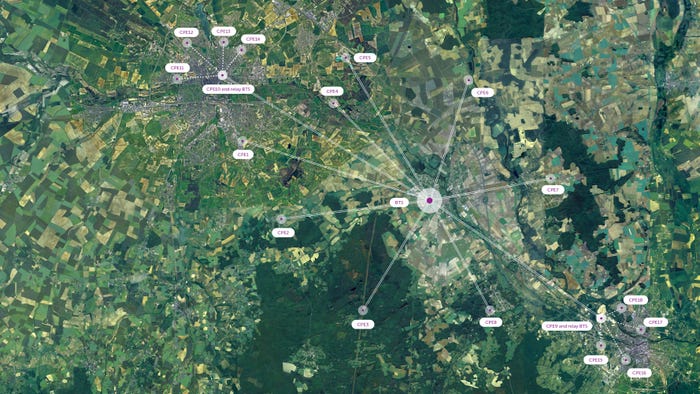Enabling 5G – Next-generation Self-Organising Fixed Wireless Access
Fixed Wireless Access (FWA) is experiencing somewhat of a renaissance in the industry, and both service providers and vendors are making the most of the opportunity.
October 9, 2017

Telecoms.com occasionally collaborates with industry partners to allow them to share their expertise on industry topics. This piece is sponsored by CCS and in it David Turner, Head of Technical Sales at CCS, looks at some of the technology choices presented by Fixed Wireless Access.
Fixed Wireless Access (FWA) is experiencing somewhat of a renaissance in the industry, and both service providers and vendors are making the most of the opportunity. 5G has played a major part in disrupting the fixed wired market, promising high speed and performance at competitive cost points. Many traditional wireline companies are turning to wireless to complement their existing infrastructure, or enable Gigabit speeds to buildings and homes where fibre or cable does not exist. FWA is also being used in lower density rural areas over several kilometers, to provide high-speed connectivity where there is less of an economic case for deploying wired infrastructure.
Technology choices
There are several technology choice for implementing FWA, with the majority operating in the sub-6GHz unlicensed bands. The typical architecture of an FWA network consists of a multi sector Point-to-Multipoint (PtMP) base station, and lower cost outdoor Customer Premises Equipment (CPE) units connected in a fixed star architecture. Point-to-Point Microwave can also be used for some dedicated links where ROI can be justified, but this typically results in multiple radios, skilled installation, and complex RF planning. To date, the sub-6GHz unlicensed and licensed bands have been able to satisfy basic connectivity requirements, however, bandwidth is inherently limited due to poor spectrum availability, and performance is often compromised due to interference and lack of carrier grade features. The 5G movement is now opening up new and existing licensed microwave spectrum such as 26GHz, 28GHz, 39GHz bands and the unlicensed 57-71GHz mmWave bands, where cost-effective components are now becoming more widely available.
Limitations of classic PtP and PtMP solutions
One of the main issues with classic PtP and PtMP systems is the extensive radio planning that needs to be undertaken. In any deployment, multiple channels are required to manage interference. A minimum of 2 channels are required for a PtMP BTS, and interference depends on exact BTS and CPE locations – meaning that ahead of the deployment detailed planning is required by skilled RF engineers using complex RF planning tools. Post-deployment tuning is also required in order to minimise system interference, which can lead to more channels being required to meet service requirements. Using a fixed frequency plan results in limited or no resilience and self-healing capability. Any changes or growth to a fixed network typically result in a major re-plan of the network, with significant consequences on existing customer sites and SLAs.
Moreover, PtMP FWA systems are normally restricted to a fixed “star” architecture where every CPE needs to have LOS to a BTS. In practice, this imposes limits on the actual number of CPEs that are able to register to a particular base station. This, in turn, increases the per-link price and increases the number of bases stations required for a given CPE population, with most networks never reaching the designed CPE population density.
In terms of design, PtMP base stations consist of multiple expensive sectors to provide greater than 90 degrees field of view. Planning considerations in urban environments can often limit the number of units that can be attached to building and street furniture. Furthermore, multiple radios could be required at relay sites consisting of BTS sectors and CPEs – leading to more inflexibility, more RF planning, and more radios to overcome LOS issues or extend the range of the network. Since licensed spectrum is a limited resource, PtMP FWA networks often reach a breaking point where the number of channels required to provide an interference free network exceeds the available bandwidth allocated to the operator.
Another major challenge is that the majority of classic PtP and PtMP solutions operate on a FDD basis, meaning equipment is configured to transmit and receive in a specific channel in a specific direction. FDD channels are allocated in pairs meaning the downlink and uplink ratios are fixed at 50:50. The maximum available capacity from a BTS node is then restricted to a few hundred Mbps in the downlink, and same in the uplink directions. FDD mode of operation therefore results in inefficient use of spectrum as the traffic US/DS ratio is dynamic and usually asymmetric. Due to the FDD configuration, BTS nodes and CPE nodes have fixed roles and are not interchangeable. As a result, TDD is now the allocation methodology adopted by the FCC (and being discussed by ETSI) in the 5G Report and Order 16-19.
So, while PtP and PtMP microwave and mmWave solutions are indeed being proposed and used for pre-5G FWA networks, traditional system design and old-fashioned concepts result in weakness and challenges that lead to higher CAPEX and operational issues that mount up considerably over time.
A new approach – self-organising 5G FWA
CCS – Cambridge Communications Systems – is delivering on its vision to provide a next-generation microwave solution that is easy to deploy and easy to scale. The co-founders of CCS bring extensive expertise – having formed two previous multipoint microwave companies – and have been able to draw on this experience to address the issues posed by classic microwave networks. CCS’s Metnet system has duly been designed – from the outset – to deliver the advantages of classic PtMP and PtP architectures while resolving many of their weaknesses. Through the innovation of a flexible multipoint-to-multipoint architecture which offers self-organising, self-healing and self-optimising capabilities, CCS Metnet is today supporting ad-hoc organic growth of networks without the continual re-planning, re-optimising, and maintenance drawbacks of classic PMP networks.
Additionally, while some 5G FWA service providers are targeting an aggressive goal of a low cost self-installed CPE for the residential market, in practice will result in a major up-front investment due to expensive base station infrastructure and mobile core technology. Instead, a lower barrier to entry in the 5G bands can be realised using Metnet, which has the ability to start small and grow as you go whilst delivering high end user capacity.
Available now and live in major implementations across the globe, the Metnet approach to 5G FWA provides very considerable benefits, including:
Designed to be an integrated component of modern data networks utilising full SON and SDN concepts
More flexible architecture supporting any topology – not limited to star topology
Simpler, faster planning and rollout (no complex RF planning needed)
Faster deployment (15-minute installation time by non-telecoms specialists)
Greater spectral efficiency through a single wide channel, adjustable DL:UL ratios to fit traffic patterns, with dynamic bandwidth allocation across the system.
Higher capacity per hub node and remote CPE node: better spectral efficiency enabling higher throughput in the same frequency allocation
More resilient network through self-healing capabilities
Better scalability: very easy to add new sites without re-planning the network or manual re-alignment
Superior latency suitable for 4G/5G networks
Robust deliver of synchronisation: GPS, 1588 and SyncE in dense urban environments
Common unit provides all radio functions – auto configuration of node according to the role in the network. No base-station, CPE split, and all units use the same filters and frequencies
Much simpler operational and spares management through a single hardware units that performs all functions in the network for any channel. No need to stock multiple variants for multiple network elements (e.g. hub controllers, sector radios, remote nodes)
Lower CAPEX and OPEX by reducing complex manpower-related costs

Example Pre-5G Metnet self-organising FWA deployment in rural Europe. 4.8Gbps per BTS using a single 28GHz channel, 5KM+ coverage, low cost CPE delivering 1Gbps peak per customer, integrated self-backhaul for local coverage extension.
CCS Metnet enables high capacity and low latency 5G FWA services for both enterprise and residential customers. Thanks to its combined point-to-multipoint and mesh architecture – with 4.8Gbps base station capacity and up to 1Gbps peak capacity available for each customer end-point – Metnet offers an optimal 5G FWA solution for deployment across dense urban, suburban and rural areas.
With unique self-organising microwave backhaul and access capabilities delivered over the same infrastructure, Metnet provides exceptional support for both carrier class mobile and data services. Metnet’s low-cost, small form factor nodes can be rapidly deployed as base stations without any radio planning – allowing discreet consumer Customer Premise Equipment (CPE) to be quickly mounted externally with no aesthetic issues and at low cost.
Providing long range connectivity of up to 5km, Metnet’s self-organising relay capability removes the need for line-of-sight from the base station to the CPE, expanding the possibilities for ubiquitous 5G FWA services.
To arrange a free consultation with our dedicated 5G FWA experts, please get in touch.
http://www.ccsl.com/enabling-5g/
 David leads CCS’ technical sales. He has 18 years’ experience in telecommunications, with particular focus on microwave/optical transport, small cell networks and indoor building solutions. David’s experience includes end-to-end solutions architecture, network design and RF planning, and global customer support and training for mobile operators, ISPs and equipment vendors. David holds a BEng(Hons) degree in Electronic and Communication Systems Engineering.
David leads CCS’ technical sales. He has 18 years’ experience in telecommunications, with particular focus on microwave/optical transport, small cell networks and indoor building solutions. David’s experience includes end-to-end solutions architecture, network design and RF planning, and global customer support and training for mobile operators, ISPs and equipment vendors. David holds a BEng(Hons) degree in Electronic and Communication Systems Engineering.
Read more about:
DiscussionAbout the Author
You May Also Like












_1.jpg?width=300&auto=webp&quality=80&disable=upscale)
